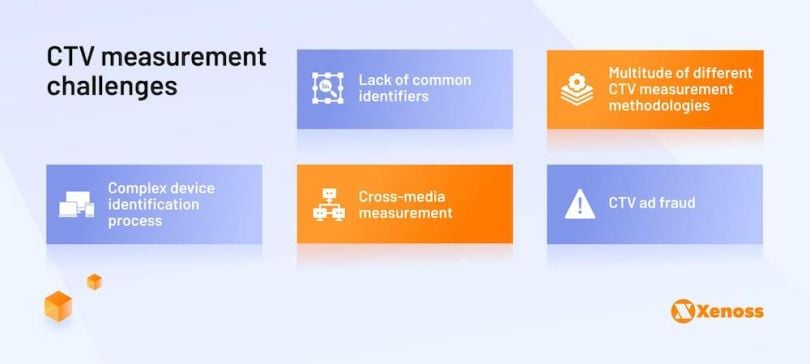Connected TV is having its moment, both as a vehicle for content consumption and an advertising channel. Insider Intelligence projects that 67.8 percent of the U.S. population will watch content on CTV devices in 2023. Marketers are betting high on CTV as it enables targeted advertising fueled by a wealth of user data. Connected TV ad spending in 2022 more than tripled compared to 2019 and is expected to increase by 14.4 percent in 2023.
To secure this growth in the upcoming years, players in the CTV market must address several problems undermining the field’s stability and maturity. The difficulty of accurately measuring and attributing ad views, conversions, and ROI is probably the biggest one. In fact, 57 percent of brand marketers and agency executives who participated in a survey on this subject by Digiday and Innovid in 2021 cited inconsistent measurement as their key obstacle.
In this article, we’ll discuss the main issues with CTV ad measurement and some ways businesses can address them.
What Are Connected TV Devices?
The market overview will help us understand the root cause of measurement challenges.
The main types of players in the market are as follows:
4 Types of Connected TV Devices
- Smart TV devices with native operating systems (e.g., Samsung TV, LG TV, Sony, Vizio with built-in Chromecast)
- Standalone streaming gadgets and media players ( e.g., Amazon Fire TV, Apple TV, Roku, Chromecast)
- Over-the-top (OTT) video-streaming services (e.g., AT&T TV, HBO Max, Hulu, Netflix, Disney+, Amazon Prime, etc.)
- Content distribution platforms (e.g., Castify.ai, BitCentral, Amagi, Viaccess-Orca, etc.)
Such a variety of services and devices means consumers have plenty of options for watching content. In turn, media buyers must manage ad campaigns in multiple environments to maximize their reach. That’s not an easy task, given that every CTV player uses unique standards and methods for measuring audiences and reporting on campaigns. Moreover, obtaining CTV ad performance data from multiple sources is technically complex. Device and data fragmentation of the CTV market complicate measurement.
CTV Measurement Challenges
Five major challenges make it difficult to measure the effectiveness of an ad campaign in a CTV marketing environment.

Lack of common identifiers
CTV must devise a standard method of identifying users across devices and content platforms. Today, the CTV advertising market relies on IP addresses for targeting and remarketing. These methods are not 100 percent accurate in attributing ad views and conversions to specific individuals or devices, however. People within the household may have the same streaming account but watch content from different devices. Additionally, IP addresses may change if they are dynamic or can be masked by VPNs, further complicating attribution.
In fact, IP addresses are under pressure, and it’s unclear how long they will remain in use. Why? The reason is privacy concerns: IP addresses are considered personally identifiable information (PII) under GDPR and the California Consumer Privacy Act. Google responded to this legislation by introducing IP Protection (previously known as Gnatcatcher), which proposes to anonymize user IPs.
Numerous measurement metrics
The variety of ad measurement approaches and metrics also stems from market fragmentation. Media buyers want to analyze campaign performance using familiar linear TV and programmatic metrics. Many adtech vendors struggle to provide this diverse set of metrics, however.
That’s why demand-side platforms (DSPs), supply-side platforms (SSPs), and media buyers use third-party measurement solutions as additional sources of precise and unbiased analytics results. For example, Amazon Ads uses Adjust and Roku uses Nielsen’s ad deduplication tool.
Due to market fragmentation, advertisers may buy placements directly from CTV/OTT platforms or purchase ads programmatically using ad platforms. As a result, audience and ad performance data get siloed between several entities that follow different approaches to measurement. In this case, advertisers may face problems with integrating data, interpreting it, and bringing it to a unified format.
Complex device identification
Advertisers reaching audiences in this channel usually get household-level exposure data. One is left to wonder whether it’s an individual or several people seeing the ad on one device. It’s challenging to obtain granular insights into ad viewership when advertising on CTV compared to other channels (e.g., web, in-app, etc.).
Cross-media measurement issues
Viewers switch gadgets and platforms when watching content, which means data about their activity rests in the systems of various market players. Since most of these companies don’t exchange audience data, brands can’t get a unified view of video content viewership rates.
Ad fraud
Because this ecosystem lacks consistent measurement standards, common user identifiers, or straightforward device identification methods, it’s a perfect playground for fraudulent activity. Mainly, IP-based targeting opens opportunities for bad actors. They can alter IPs by using proxies to create a network of fake devices that mimic real users’ actions to generate ad impressions and steal ad dollars. The latest report on invalid traffic (IVT) and ad fraud from Pixalate helps us understand the scale of ad budget losses due to malicious actions: The global IVT rate in the open programmatic CTV ad marketplace reached 21 percent on Roku and Amazon Fire TV devices in Q1 of 2023.
How to Fix CTV Campaign Measurement
Although getting accurate insights into CTV campaign performance is still tricky, advertising industry organizations and adtech vendors introduce measurement solutions and approaches for both buy- and sell-side businesses. We’ll discuss several CTV measurement best practices you can implement today.
7 Ways to Improve CTV Campaign Measurement
- Follow a hybrid approach to cross-channel attribution.
- Experiment with ID solutions.
- Define the optimal approach to audience measurement.
- Use pixel-based technology.
- Embedded software development kit (SDK) or client-side measurement code for cross-channel measurement.
- Use automated content recognition.
- Decide on the best reporting options.
Follow a hybrid approach to cross-channel attribution
Limited access to audience data complicates attribution. On the bright side, the industry is experimenting with various approaches to determine users’ identities and monitor their engagement with content.
IAB Europe suggests employing hybrid ways to measure campaigns combining:
- Automatic content recognition (ACR) methods like audio fingerprinting or watermarking.
- Passive panel metering technologies such as people meters or portable people meters.
- Digital metering using linked mobile devices or home router-level meters.
- Third- or first-party census feeds.
By combining these signals, industry players can minimize deduplication and better distinguish between linear TV, broadcaster video-on-demand (BVOD), or CTV app feeds at household and individual levels.
In addition, it’s possible to cross-match user IDs like identifiers for advertisers (IFAs), CTV IDs (identifiers associated with specific CTV devices), device IDs, and IP addresses with audience profiles across platforms.
Experiment with ID solutions
Identity solutions can help advertisers understand interconnections between devices (smart TVs, tablets, or smartphones) in the household by tying them with their respective owners.
Unified ID 2.0 is one of them. Unified ID 2.0 is an open-source, interoperable, privacy-centric identity solution. It uses deterministic data — encrypted emails and phone numbers — to connect persons to the numerous endpoints they use.
Businesses can also consider Epsilon’s CTV offering that relies on its CORE ID. The solution allows for identifying customers at the personal level.
Identity solutions make granular targeting and measurement possible.
Define the optimal approach to audience measurement
Since CTV is a cookieless environment, audience measurement isn’t an easy task. Media buyers have workarounds, however. In 2019, the Media Rating Council (MRC) introduced a comprehensive set of standards and methods for measuring cross-media CTV audiences. The two approaches are:
Use pixel-based technology
The option entails placing pixels on an ad to track impressions, capturing video starts, learning the number or percentage of viewers who watched an ad to the end, and detecting and reporting invalid traffic.
Embed software development kit (SDK) or client-side measurement code for cross-channel measurement
Open Measurement SDK (OM SDK) by Tech Lab is one of them. The OM SDK includes common code and libraries to facilitate access to measurement data for third parties — advertisers and measurement providers.
Use Automated content recognition
To refine audience measurement, advertisers can work with CTV market players that leverage automated content recognition (ACR), the technology we mentioned earlier.
Automated content recognition entails identifying video and audio content on a smart TV, tablet, mobile, or computer screen. ACR captures a signal from playing content and cross-references it with a library or database to find a match.
Devices that support this technology allow for capturing the following data points:
- Platform type — linear, MVPD, CTV, or another VOD service
- Geolocation
- IP address
- Demographics
- Viewership behaviors — average watch time, ad completion rates, channel surfing parameters, and more.
Decide on the best reporting options
Standard metrics like viewable impressions, quartile rates, and completion rates may not always accurately represent CTV ad performance. Take the much-discussed “TV off” problem, for instance. In 2022, the ad verification software provider DoubleVerify found content and advertising continued running when TV sets were turned off; the issue was spotted in one of four top CTV environments. As a result, media buyers got unrealistic viewership rates and wasted parts of their ad budgets.
The industry has been working on solving this and related viewability measurement issues. The 1.4 release of OM SDK includes new CTV-specialized signals, such as display connection status signalling if the TV display is off, while an application may still be running, and the last activity within an app to determine that a person is still watching content. In addition, DoubleVerify recently introduced a solution claiming it can help media buyers understand if ads play after a TV is off.
IAB Europe notes it’s important to compare the performance of CTV ads against other formats available to the media buyer. The conventional approach of comparing viewability rates isn’t sufficient because it doesn’t consider the cost of media. Instead, the association advises using the cost-per-completed viewable view (CPCVV) metric, which is “a far more efficient benchmark than traditional CPM or viewability alone ” since advertisers need to distinguish between ad exposure and completed viewability.
The association also suggests comparing the level of co-viewing of a CTV ad versus an individual’s view of a non-CTV digital ad.
Refine CTV Advertising
CTV viewership has been snowballing in recent years, with more and more consumers preferring streaming services to traditional TV. Marketers couldn’t ignore the channel’s potential to reach an ever-growing audience, and nowadays, connected TV is an integral component of an advertising channel mix.
Market fragmentation is the root cause of the lack of ad performance measurement and attribution standards. Although the industry is still solving the measurement issue, practices to improve visibility into CTV ad performance are already available for media buyers.





